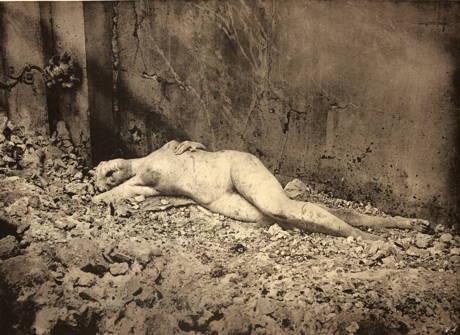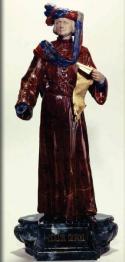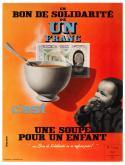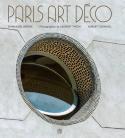Art Of The Day Weekly
#471 - from 4 May 2017 to 10 May 2017

Photo Unit of the Royal Prussian Army. Reception Hall in the Château de Saint-Cloud with statue The Death (in Images de la vie militaire à Paris et Strasbourg pendant la campagne de 1870-71, J.B Obernetter (publisher), 1870. Berlin, Stiftung Deutsches Historisches Museum © Deutsches Historisches Museum, Berlin.
IN THE AIR
History lessons for troubled times
Recent political debates in France and elsewhere like in England and Italy systematically underestimate the role a united Europe had in the peace and economic prosperity of the continent. The wave of simple ideas – such as corrupted elites, the foreigner who takes advantage etc. – and of quick solutions feed on that amnesia. By constantly living in the present no one learns from the lessons given to us by history. It is very positive that some history exhibitions be brought to the forefront on dates as symbolic as May 1 and May 8. The one the musée de l’Armée has dedicated to the Franco-Prussian war from 1870 and to the Commune of 1871 is fascinating, by the quality of its computer graphics (the arrival for example of Mac-Mahon when Paris is on fire during the Bloody Week - Semaine sanglante – and by the great variety of the objects brought together. There is the basket of the balloon Le Volta, a shiny Bollée machine gun, small Moulins balls to send mail by waterways, a fragment of the panorama of the battle of Champigny by Detaille (formerly installed over 2025 m2 at the top of the Champs-Elysées), the horns of the last beef eaten in Paris before the famine. But what is also very fascinating are the questions it leads to by repeating the sad mechanism of the disaster: the fiery declarations made by a leader (in this case Napoleon III as he spoke of national greatness); the contempt shown for any diplomatic solution; the sounding board found in public opinion heated up by simplistic slogans. Analogies only mean something to those who remember them: what a shame they are so few.
• France-Allemagne(s), 1870-1871 at the Musée de l’Armée, from April 13 to July 30, 2017.
EXHIBITIONS

Georges Lemaire. Étienne Marcel, Musée des Beaux-Arts de la Ville de Paris, Petit Palais. © Petit Palais / Roger-Viollet.
Governing Paris
PARIS - The mayor of Paris, whether male or female, is a national figure. Among the younger generations no one remembers the role is very recent. Central power in France, fearing any revolt in the capital and traumatised by the experience of Etienne Marcel who stood up to Charles V in the XIVth century, has done everything to prevent the expression of a municipal power. Aside from sporadic revolts during revolutions as in 1848 or 1789, it was only in 1977 that the mayor of Paris, Jacques Chirac, was elected by universal suffrage. This exhibition brings together historic documents such as coats of arms, paintings, court orders, ancient maps, photos and movies, and shows that the city that created such fear due to its capacity to set up barricades (a Parisian specialty) succeeded even when it was harnessed to preserve a part of autonomy through associations such as brotherhoods, parochial factories or labour exchanges.
• Le gouvernement des Parisiens at the Hôtel de Ville, from April 22 to July 22, 2017.
War menu
LYON – The centre of the history of the resistance and deportation pursues its analysis of daily life during World War II, and now focuses on nutrition. We believe today that our society of abundance is something normal. We can´t imagine that just a few decades ago people drank coffee made from acorns, that anaemic children were strengthened with beef blood, that people only ate stale bread since it was forbidden to sell fresh one and that many families bred a rabbit right in their living room to ensure the needed proteins. That was the situation in most French cities and towns during the German Occupation when housewives stood in endless queues and claimed their rationing ticket to buy turnips. This shortage of goods nourished a certain black humour that spoke of meatless meatloaves and vegetable soups without vegetables. It influenced contemporary music such as the hit by Fernandel Les Jours Sans (Days without), but the memory of the 1,000 calories available in certain towns (compared to the necessary minimum of 2,500) has truly disappeared.
• Les jours sans. Alimentation et pénurie en temps de guerre at the Centre d’histoire de la Résistance et la Déportation, from April 13, 2017 to January 28, 2018.
Luther, 500 years ago
BERLIN - In October 1517, Luther covered the door of his church in Wittemberg with his 95 theses and opened the way to the Protestant Reform. It changed the face of Europe but its confrontation with Catholicism caused wars and massacres, among which the one of Saint-Barthélemy in France. What can we learn from this while peoples in other regions experience violent religious conflicts?
• The Luther Effect at the Martin-Gropius-Bau, from April 12 to November 5, 2017.
Greeks in Italy
POMPEII – The fear of the foreign coloniser is universal. How was the problem faced over twenty-five centuries ago, when Greek migrants came to trade and settled on the coasts of Campania, founding Neapolis that would become Naples?
• Pompei e i Greci, at the Scavi di Pompei, froñ April 12 to November 27, 2017.
BOOKS
Paris, the memory of Art déco
Following World War I, Europe tried to conjure during the roaring twenties - les Années folles – the new disaster that was looming. The period, which was incarnated by Joséphine Baker, the restaurant Le Bœuf sur le toit, jazz and the paintings by Tamara de Lempicka, also gave birth to a magnificent architectural production. While we easily date Art déco from the International Exposition of 1925, it really goes beyond those limits. In this book we go back to the first creations by Auguste Perret (among the théâtre des Champs-Elysées, 1911) and we can push as far as 1938 with the Dutch school at the international university campus at the Cité universitaire. The former museum of African and Oceanic arts (arts d’Afrique et d’Océanie), the Coupole restaurant, and the Rex cinema are iconic proofs. But the interest of the book is to remind the reader that the Art déco aesthetic affected all sectors including the post office, high schools, theatres such as the Folies-Bergère, apartment buildings and even pools (Piscine Molitor). The Banque Transatlantique, which contributed to finance the book, has a remarkable setting, that of the former Scalbert-Dupont bank. But we regret the notes are not as detailed on other unknown flagships such as the building on avenue Stéphane-Mallarmé, of which the photographs efficiently render the geometric perfection.
• Paris Art déco, by Emmanuel Bréon and Hubert Cavaniol, photo by Laurent Thion, Somogy, 2017, 240 p., 39 €.
OPENINGS OF THE WEEK

DENIS DARZACQ - CONTREFORMES
6 May 2017 - PARIS - Galerie RX
A foray into abstraction by a photographer known for his interest in the human figure


